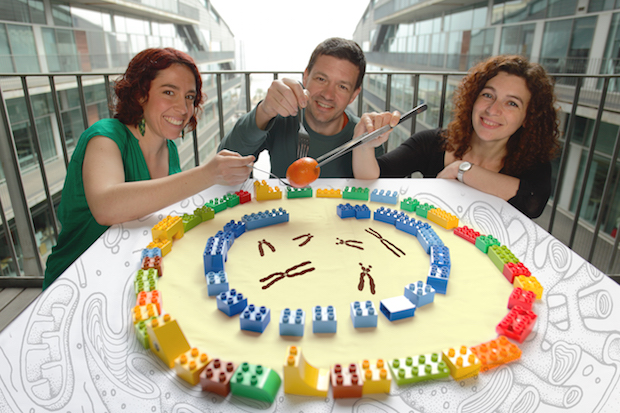Cell & Developmental Biology Programme
Researchers at the Centre for Genomic Regulation in Barcelona have uncovered a new quality control system in our cells, specific to the inner nuclear membrane, a specialised part of the endoplasmic reticulum
It is impressive to watch the giant robotic 1600-armed army assemble a whole new car in a matter of a few hours in SEAT, the Spanish car company. This plant, located 30 km from Barcelona, produces 2000 cars every day. The robots first perfectly stamp out the different parts and then, with exquisite precision, they weld them and apply filler before sending them for painting. Like some kind of huge slot car, pieces travel from one place of the factory to another via a railway-like aerial system.

In the vehicle industry, almost the entire production chain is automatic, as machines know more about repeating accuracy than humans. Even so, there are strict quality control tests at several points during the process to make sure no mistakes are made. If any defective pieces are detected, they are immediately separated and eliminated from the assembly chain.
Also, if a piece is misplaced at any point in the chain, the quality control systems find it and promptly remove it. They are very precise, as any failure could result in a defective car on the roads, endangering the driver. Or, alternatively, there would be no car at all.
These quality control systems are not exclusive to the car industry, of course. In fact, all industrialised market sectors have them, as do the cells in our body, to ensure that they function well.
Ensuring proper cellular function
The basic cellular building blocks are protein molecules, millions of them, which have both structural and regulatory functions. These molecules are continuously being produced and transported to different cellular locations, even outside the cells, to accomplish their purpose, such as communicating with neighbouring cells. To do this, the newly-made spaghetti-like protein molecules need to adopt the correct three-dimensional structure that enables them to work properly.
This reshaping process occurs in an organelle known as the endoplasmic reticulum, a network of membranes that spreads throughout the cell and which also forms the nuclear envelope that wraps the chromosomes. In such a complicated process mistakes can be made. Factors like mutation, stress or simply age, can interfere with the folding process and induce proteins to adopt incorrect 3D forms. If these abnormal molecules accumulate, they eventually become toxic, as occurs in Alzheimer’s disease with the aggregation of beta-amyloid.
“Cells evolved mechanisms to prevent the accumulation or secretion of abnormally folded proteins, as these would not be able to perform their proper functions or provide the right information. These mechanisms are quality control systems, just like in a production chain or manufacturing process”, explains researcher Pedro Carvalho, group leader in the Organelle Biogenesis and Homeostasis laboratory at the CRG.
These quality control mechanisms are very precise and able to detect small structural defects in proteins and eliminate them before they reach their final destination. The pathways are well known and have been characterised and studied for a long time, as they are very important for the cell’s survival.
A new pathway discovered
Now, a team of researchers at the Centre for Genomic Regulation in Barcelona, led by Carvalho, has published a paper in Science describing a new quality control system in our cells. It is specific to the inner nuclear membrane, a specialised part of the endoplasmic reticulum (ER).
The ER is the major organelle in the cell involved in the biosynthesis of proteins. It also forms a barrier between the nucleus and the cytoplasm consisting of two membranes, which although continuous are very distinct, with different protein compositions and which perform distinct functions. For example, the one on the nuclear side, the so-called inner nuclear membrane, is thought to play a key role in genome organisation.
“We found that the proteins which are transported to the inner nuclear membrane also undergo quality control in case they are damaged or misfolded”, states postdoctoral researcher at the CRG, Ombretta Foresti, co-author of the paper.
“Also, proteins that mistakenly end up in the inner nuclear membrane are degraded by this system, even if they are perfectly folded. Because of this, the pathway appears important for maintaining the differential protein composition of the inner and the outer nuclear membranes”, adds Carvalho. But the researchers do not yet know how cells recognise when these proteins are not in the right place.
The newly identified quality control system, based on a unicellular model organism, the Baker’s yeast, Saccharomyces cerevisiae, protects the cell nucleus by targeting foreign proteins that could enter by mistake. And this could be particularly significant in non-dividing cells, like neurones, where the inner nuclear membrane is isolated from the rest of the ER for long periods of time.
There are a great number of diseases and syndromes that are characterised by an accumulation of defects in the nuclear envelope, many of which are linked to the aggregation of damaged proteins. They include laminopathies, diseases characterised by defects in the nuclear lamina that can lead to muscular dystrophy. The findings of the Organelle Biogenesis and Homeostasis group are important as they give us clues about how the cell works and could, in the long run, provide information on how damaged proteins in the inner nuclear membrane are degraded.
Reference work
Foresti O, Rodríguez-Vaello V, Funaya C & Carvalho P. “Quality control of inner nuclear membrane proteins by the Asi complex”. Science. 2014 Nov 7. 346(6210):751-755 . http://dx.doi.org/10.1126/science.1255638